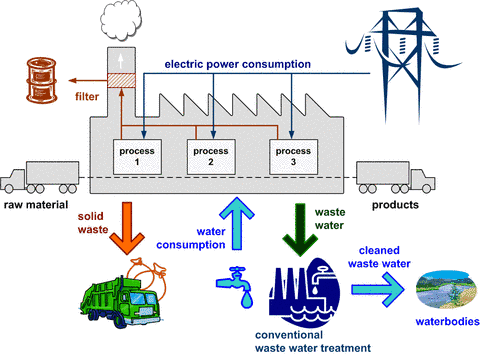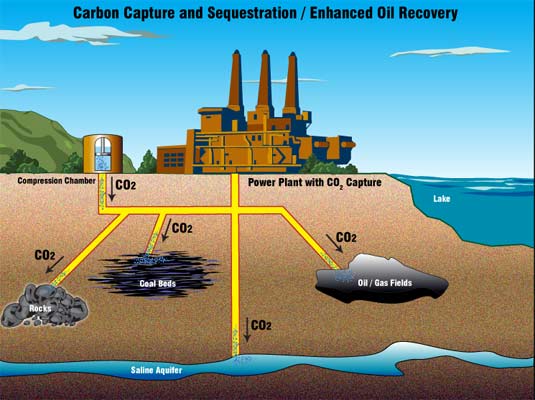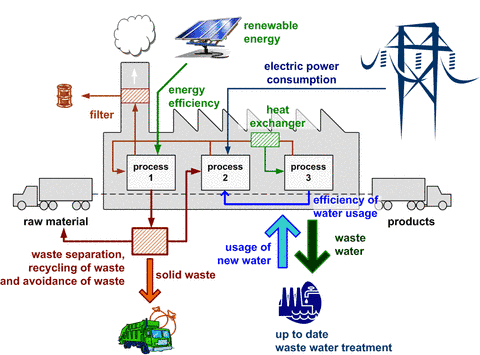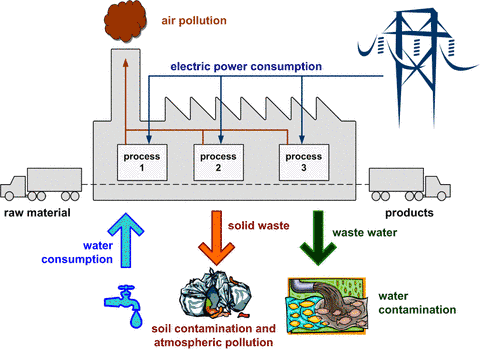Clean technology is found in a broad range of industries, including water, energy, manufacturing, advanced materials and transportation. As our Earth’s resources are slowly depleted, demand for energy worldwide should be on every designer’s mind when generating products, systems and services. The convergence of environmental, technological, economic and social factors will produce more energy-efficient technologies that will be less reliant on obsolete, polluting technologies.
The legislation (law) for reducing pollution often focuses on the output and, therefore, end- of-pipe technologies. By implementing ideas from the circular economy, pollution is negated and waste eliminated.
Drivers (push) for Cleaning up Manufacturing:
Manufacturers may react to:
- Legislation is a driving force for industry to clean up manufacturing processes.
- current or forthcoming legislation (laws)
- to conform with government legislation
- to avoid penalties
- Pressure created by the local community and media
- communities have made it known that they don’t want harmful (to humans, ecology and the environment) industries
- pressure groups such as Greenpeace or even a small community town
- this can sometimes force legislation to be developed and enacted
Reasons for cleaning up manufacturing/industry include:
- promoting positive impacts
- ensuring neutral impact or minimizing negative impacts through conserving natural resources
- reducing pollution and use of energy
- reducing waste of energy and resources
International Legislation and Targets
International legislation and targets are developed for reducing pollution and waste:
Term: Legislation – Laws considered collectively to address a certain topic.
- The role and scale of legislation are dependent upon the type of manufacturing and the varied perspectives in different countries.
- Legislation (as mentioned above) provides a motivation (perhaps not willingly) for industry to clean up manufacturing processes.
- Manufacturers react to the legislation by cleaning up there act or ignoring it (this happens in some countries as legislation not be forced).
- Manufacturers dont want to pay to clean up production; this cuts into profits.
- International targets, such as those of the Kyoto Protocol in 1997 (see video below), The Copenhagen Accord in 2009, The Paris Agreement in 2015 are set and agreed upon for reducing green house gases to combat global warming.
- The difficulties of getting nations to agree to the targets which can be for many reasons, such as, nations being at different stages of economic and social development, attitudes to the the environment, or placing more value on economic gain than the environment.
- Legislation is monitored and policed and how it can be promoted for manufacturers.
- How legislation can be monitoring and policing
- The UN on water
- Legislation (as mentioned above) provides a motivation (perhaps not willingly) for industry to clean up manufacturing processes.
- Is it ethical to prevent a developing country from producing high carbon emissions through industrial development when developed countries have been the main generators of carbon emissions through their own industrial revolutions and economic development?
- China is a current example as it has done in 20 odd years what it took USA and Europe about 100 years.
Incremental and Radical solutions
Incremental solutions
Term: Incremental solutions – Products which are improved and developed over time leading to new versions and generations.
- Often, manufacturing processes are improved in terms of efficiency and amount of embodied energy over time.
- This incremental development of a manufacturing process can require major refits and the addition of new elements to a manufacturing process.
- Which allows a company to plan strategically how it will make he changes – this allows for better budget control but requires long term planning.
- the impact is not as drastic as radical solutions.
| Advantages | Disadvantages |
| Use of existing trusted technologies. | Take too long. |
| No/limited down time in production (continued profits) | Small changes may not meet the overall legislation requirements. |
| Less uncertainty of success due the trusted, known technology. | Need to make small changes often. |
| Can quickly respond to legislation (forthcoming or changing). | Saturated (crowded) marketplace/ competition. |
Radical solutions
Term: Radical solutions – Where a completely new product is devised by going back to the roots of a problem and thinking about a solution in a different way.
- Radical solutions can make a great and sudden impact;
- They can require the replacement of a whole system.
- This can be costly and time consuming where a company maybe in down time
| Advantages | Disadvantages |
| Exploration of new technologies. | Costly (both if technology outfitting and loss of profits during down time). |
| High potential for market growth. | Costly R&D, training and capital (equipment). |
| Creation of new industries. | High uncertainty of success. |
| Fewer competitors. | Possibility of high market resistance. |
| Patening new solutions – financial and repetitional benefits. | Development unpredictable incorporating specific starts and stops. |
| Enhance reputation and innovative and radical. |
End-of-Pipe Technologies
Term: Technology that is used to reduce pollutants and waste at the end of a process.
- Technology that is used to reduce pollutants and waste at the end of the industries production processes.
- Industries include, water, energy, manufacturing, advanced materials and transportation.
- Example of this are filters installed on the end of industrial smoke stacks.
 |
 |
| End-Of-Pipe | End-Of-Pipe vs Clean Production |
 |
 |
System Level Solutions
Term: Solutions that are implemented to deal with the whole system, rather than just components.
- Is concerned with the prevention of pollutants as a whole – i.e. production system wide
- Often radical implementation
 |
 |
Articles of interest
- Clean Production vs End of Pipe
- Clean technology Website from where the images came from
- Clean technology and profits
Clean Technology
Term: Products, services or processes that reduce waste and require the minimum amount of non-renewable resources.
“Clean technology includes recycling, renewable energy (wind power, solar power, biomass, hydropower, biofuels, etc.), information technology, green transportation, electric motors, green chemistry, lighting, greywater, and many other appliances that are now more energy efficient. It is a means to create electricity and fuels, with a smaller environmental footprint and minimise pollution. To make green buildings, transport and infrastructure both more energy efficient and environmentally benign” (wikipedia accessed Jan 19 2016).
 |
 |
International Mindedness
The development of clean technology strategies for reducing pollution and waste can positively impact local, national and global environments.
Theory of Knowledge
International targets may be seen to impose the view of a certain culture onto another. Can one group of people know what is best for others?
Something Extra …